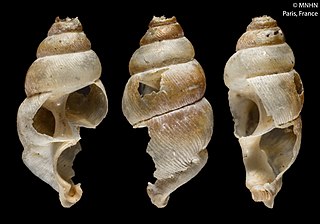Boucardicus albocinctus is a species of land snail with an operculum, a terrestrial gastropod mollusc in the family Alycaeidae.

Boucardicus is a genus of land snails with an operculum, terrestrial gastropod mollusks in the family Alycaeidae.
Boucardicus antiquus is a species of land snail with an operculum, a terrestrial gastropod mollusc in the family Alycaeidae.
Boucardicus carylae is a species of land snail with an operculum, a terrestrial gastropod mollusc in the family Alycaeidae.
Boucardicus culminans is a species of land snail with an operculum, a terrestrial gastropod mollusc in the family Alycaeidae.
Boucardicus curvifolius is a species of land snail with an operculum, a terrestrial gastropod mollusc in the family Alycaeidae.
Boucardicus delicatus is a species of land snail with an operculum, a terrestrial gastropod mollusc in the family Alycaeidae.
Boucardicus divei is a species of land snail with an operculum, a terrestrial gastropod mollusc in the family Alycaeidae.
Boucardicus esetrae is a species of land snail with an operculum, a terrestrial gastropod mollusc in the family Alycaeidae.
Boucardicus fidimananai is a species of land snail with an operculum, a terrestrial gastropod mollusc in the family Alycaeidae.
Boucardicus magnilobatus is a species of land snail with an operculum, a terrestrial gastropod mollusc in the family Alycaeidae.
Boucardicus mahermanae is a species of land snail with an operculum, a terrestrial gastropod mollusc in the family Alycaeidae.
Boucardicus rakotoarisoni is a species of land snail with an operculum, a terrestrial gastropod mollusc in the family Alycaeidae.
Boucardicus randalanai is a species of land snail with an operculum, a terrestrial gastropod mollusc in the family Alycaeidae.
Boucardicus simplex is a species of land snail with an operculum, a terrestrial gastropod mollusc in the family Alycaeidae.
Boucardicus tridentatus is a species of land snail with an operculum, a terrestrial gastropod mollusc in the family Alycaeidae.
Boucardicus victorhernandezi is a species of land snail with an operculum, a terrestrial gastropod mollusc in the family Alycaeidae.

Endangered species, as classified by the International Union for Conservation of Nature (IUCN), are species which have been categorized as very likely to become extinct in their known native ranges in the near future. On the IUCN Red List, endangered is the second-most severe conservation status for wild populations in the IUCN's schema after critically endangered. In 2012, the IUCN Red List featured 3,079 animal and 2,655 plant species as endangered worldwide. The figures for 1998 were 1,102 and 1,197 respectively.


